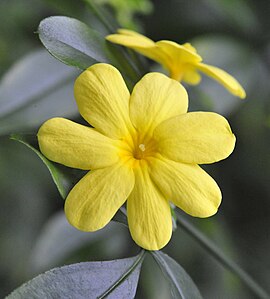Comments
provided by eFloras
Very common in Rawalpindi gardens for spring flowers.
- license
- cc-by-nc-sa-3.0
- copyright
- Missouri Botanical Garden, 4344 Shaw Boulevard, St. Louis, MO, 63110 USA
Description
provided by eFloras
Shrub twiggy, glabrous; branches 4-angled, overhanging. Leaves opposite, up to 10 cm long, petiolate, trifoliolate; leaflets sessile or subsessile, narrowly elliptic to oblong-lanceolate or oval, apiculate, dark green above, paler beneath, venation closed. Flowers scentless, solitary on axillary peduncles. Calyx short; lobes 6, c. 5 mm long. Corolla bright yellow, orange in the throat, single or double, tube stout, lobes usually 6, obovate, rounded, c. 2.5 cm long. Fruit a didymous or simple berry, ellipsoid, up to 1 cm long and 6 mm in diameter, each part containing 1 or 2 seeds.
- license
- cc-by-nc-sa-3.0
- copyright
- Missouri Botanical Garden, 4344 Shaw Boulevard, St. Louis, MO, 63110 USA
Description
provided by eFloras
Subshrubs erect, evergreen, 0.5-5 m. Branchlets 4-angled, glabrous. Leaves opposite, 3-foliolate or simple at base of branchlets; petiole 0.5-1.5 cm; leaf blade broadly ovate or elliptic, sometimes suborbicular, 3-5 × 1.5-2.5 cm, along with leaflet blade subleathery, glabrescent, veins obscure; leaflet blade narrowly ovate or ovate-lanceolate to narrowly elliptic, base cuneate, apex blunt and mucronulate, terminal one 2.5-6.5 × 0.5-2.2 cm, basally decurrent into a short petiolule, lateral ones sessile, 1.5-4 × 0.6-2 cm. Flowers usually solitary, axillary or rarely terminal; bracts leafy, obovate or lanceolate, 5-10 mm. Pedicel 3-8 mm. Calyx campanulate; lobes 5-8, leafy, lanceolate, 4-7 mm. Corolla yellow, funnelform, 2-4.5 cm in diam.; tube 1-1.5 cm; lobes 6-8, doubled in cultivation, broadly obovate or oblong, 1.1-1.8 cm. Berry ellipsoid, 6-8 mm in diam. Fl. Nov-Aug, fr. Mar-May. 2n = 24, 26*.
- license
- cc-by-nc-sa-3.0
- copyright
- Missouri Botanical Garden, 4344 Shaw Boulevard, St. Louis, MO, 63110 USA
Distribution
provided by eFloras
Distribution: Yunan, China. Now extensively cultivated throughout the tropical and subtropical parts of the world.
- license
- cc-by-nc-sa-3.0
- copyright
- Missouri Botanical Garden, 4344 Shaw Boulevard, St. Louis, MO, 63110 USA
Distribution
provided by eFloras
Guizhou, SW Sichuan, Yunnan.
- license
- cc-by-nc-sa-3.0
- copyright
- Missouri Botanical Garden, 4344 Shaw Boulevard, St. Louis, MO, 63110 USA
Habitat
provided by eFloras
* Ravines, woods; 500-2600 m.
- license
- cc-by-nc-sa-3.0
- copyright
- Missouri Botanical Garden, 4344 Shaw Boulevard, St. Louis, MO, 63110 USA
Synonym
provided by eFloras
Jasminum primulinum Hemsley.
- license
- cc-by-nc-sa-3.0
- copyright
- Missouri Botanical Garden, 4344 Shaw Boulevard, St. Louis, MO, 63110 USA
Jasminum mesnyi: Brief Summary
provided by wikipedia EN
Jasminum mesnyi, the primrose jasmine or Japanese jasmine, is a species of flowering plant in the family Oleaceae, native to Vietnam and southern China (Guizhou, Sichuan, Yunnan). It is also reportedly naturalized in Mexico, Honduras and parts of the southern United States (Florida, Georgia, Alabama, Louisiana, Texas, Arizona).
Jasminum mesnyi is a scrambling evergreen shrub growing to 3 m (10 ft) tall by 1–2 m (3–7 ft) wide, with fragrant yellow flowers in spring and summer. The form usually found in cultivation has semi-double flowers. It is not frost-hardy. With suitable support it can be grown as a slender climber, though in confined spaces it will require regular pruning.
Jasminum mesnyi has gained the Royal Horticultural Society's Award of Garden Merit.
Variation in flower form

Single

Semi-double
- license
- cc-by-sa-3.0
- copyright
- Wikipedia authors and editors



